It is with pleasure that we welcome our AoMs for October, Andrew Collins and Greg Little, co-authors of the new book, Denisovan Origins.
Little and Collins team up to provide a comprehensive account of the enigmatic Denisovans and their impact on the emergence of modern human society.
If they are correct in their findings, then they have discovered a missing chapter in our knowledge of the emergence of civilisation, both in the ancient world and in the Americas.
The mystery of the Denisovans’ interaction with the earliest modern humans to encounter them, and how this might have impacted the spread of new technologies and the rise of civilisation is the subject of the new book Denisovan Origins, co-authored by me, Andrew Collins, and prehistorian Dr Greg L. Little. I handle the impact of the Denisovans and their inevitable hybrids on the Eurasian continent, providing a hypothetical platform for their eventual departure to the Americas, while Greg concentrates on what might have happened on their arrival in the Americas. Greg looks at the DNA evidence of the earliest migrations into the Americas, and brings the whole subject down to the emergence of the first mound building cultures of the Americas as early as 10,000 years ago.
There are some similarities between what Greg and I write, and areas that Graham Hancock explores in his new book America Before: The Key to Earth’s Lost Civilisation (my in-depth review of which is found here). Indeed, both America Before and Denisovan Origins might be seen as forming part of a new breed of book that goes beyond the sacred cows of the past regarding the origins of civilisation. They recognise that what gave cause to civilisation’s eventual rise both in the old world and in the new world was the vestige of a pre-existing worldview forming part of a now lost mindset, one that was almost certainly inherited from our Denisovan and Neanderthal predecessors as much as 45,000 years ago.
Graham has chosen to refer to this forgotten genesis of humanity’s extended link with the cosmos as the “lost civilisation,” something reflected in the title of his book. Greg and I refer to it as the “shamanic civilisation,” since it is not so much a civilisation of roads, rivers, city states and writing, but one of a universal expanded mindset reflected in religious and magical ideas and practices, along with the building and design of geometric, liminal structures, and a universal cosmic journey of the soul centred around a perceived place of origin and place in the afterlife among the stars.
Denisovan Origins
Yet where and how did this shamanic civilisation begin? Where did modern humans first come to adopt pre-existing ideas that would ultimately lead to the spread of the shamanic civilisation, something that I am certain culminated with the foundation of Göbekli Tepe in southeastern Anatolia around 9600 BCE? Certainly, we know that modern humans will have first encountered Neanderthals in Europe and southwestern Asia as much as 65,000 years ago, and arguably even earlier still. Yet what about the Denisovans, whom we suspect had an even greater impact on the development of the shamanic civilisation than their western neighbours, the Neanderthals? Where and how did we first encounter them? What exactly happened when this went down?
It is a matter that archaeologists are turning their attention to more and more. For instance, it was announced recently that archaeological excavations in the Transbiakal region of northern Mongolia suggest that early contact between Denisovans and modern humans occurred there as much as 45,000 years ago. What is more, those responsible for these excavations are now suggesting that it might well have been the Denisovans, and not modern humans alone, who introduced the stone tool technologies that would come to dominate the Upper Palaeolithic tool kit right down to the Neolithic age. It is a finding that backs up existing evidence presented in Denisovan Origins—that it was close to the shores of a huge inland sea straddling southern Siberia and central Mongolia called Lake Baikal—that our ancestors’ interaction with Denisovans and Denisovan hybrids kickstarted human civilisation some 45,000 years ago.
Blade Tool Technologies
Between 2011 and 2016, excavations at a site named Tolbor-16 on the Tolbor River in northern Mongolia revealed many thousands of stone artefacts, with as many as 826 stone tools associated with the oldest layers of occupation. These stone tools, many as much as 45,000 years old, include blade tools that closely resemble those found at several sites that date from a similar age in both northwestern China and southern Siberia. These sites include the famous Denisova Cave located in the Altai Mountains, which is one of only two confirmed sites of Denisovan occupation from the same time period. Yet since blade tools are generally associated with stone industries of the Upper Palaeolithic age, and are usually attributed to modern humans, Dr. Nicolas Zwyns, the lead archaeologist working at Tolbor-16, concludes that the tools’ manufacture is down to our own ancestors, and not to the region’s Denisovans.
“Although we found no human remains at the site, the dates we obtained match the age of the earliest Homo sapiens found in Siberia,” Zwyns said. “After carefully considering other options, we suggest that this change in technology illustrates movements of Homo sapiens in the region.”
This is not the conclusion of his Russian colleagues, who speculate that these Upper Paleolithic stone tool industries developed from existing so-called Mousterian (or Middle Paleolithic) tool manufacture, and derive not from modern humans but from the region’s archaic human communities, most obviously the Denisovans.
Even Zwyns admits that sites such as Tolbor-16, located on the forest-steppe south of Lake Baikal, might well have been somewhere that the earliest modern humans encountered surviving Denisovan communities following their departure from Africa around 65,000 years ago. Denisovans are thought to have been present in Denisova Cave, southern Siberia, by around 200,000 years ago, and in northwestern China from at least 160,000 years ago. This last date corresponds to the age of a human mandible found in 1980 in a cave at the north-eastern edge of the Tibetan Plateau near Xiahe in northwestern China, that was only recently confirmed as being Denisovan. Further confirmation of the presence of Denisovans or at least their direct hybrid descendants on the Tibetan Plateau comes from the discovery between 2013 and 2018 of thousands of stone tools, including blades and bladelets, at Nwya Devu. Their existence predates the currently accepted presence of modern humans on the plateau by at least 20,000 years.
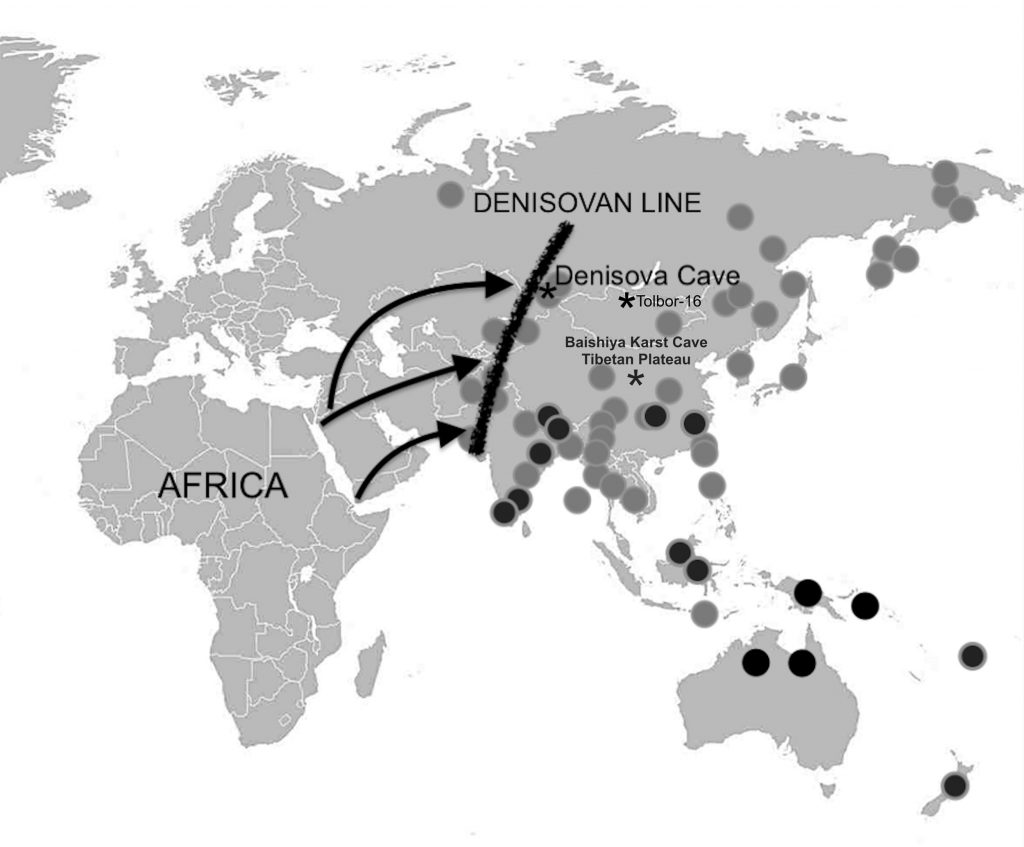
Fig. 1. Distribution of Denisovan ancestry in modern human populations, overlaid with the proposed Denisovan line, a theorised zone of first contact between the earliest modern humans and existing Denisovan populations circa 55,000-45,000 years ago. Sites of potential Denisovan contact are marked with an asterisk. (Picture copyright: A. Collins.)
The suspected Denisovan origin of the stone tools found at Nwya Devu is given weight by the finding that the EPAS1 gene that enables indigenous Tibetans and the Sherpas of the Himalayas to thrive at an extremely high altitude with very little oxygen was inherited from Denisovans. To have evolved this gene in the first place, they themselves must have thrived at extremely high altitudes for an extended period of time—for arguably tens of thousands if not hundreds of thousands of years.
Denisovan Sophistication
Yet were the Denisovans really responsible for the sudden emergence of blade technology at sites like Tolbor-16 as early as 45,000 years ago? Certainly, the presence of a very similar blade technology in the Denisovan layer of Denisova Cave dating to the same age augments this possibility, given Denisovans were seemingly present in the cave at the time.
What is more, evidence of a sophisticated mindset among Denisovans has been detected in their archaeological layer of Denisova Cave—for example, the beautiful choritolite (chlorite) arm bangle dubbed “the Denisovan bracelet,” the earliest known bone needles, the fragments of a bone whistle or flute, a large mammoth ivory headband, and an ocher “pencil” with evidence of usage.
All this evidence suggests that by 45,000 years ago and arguably earlier, the Denisovans displayed immense technological capability and advanced human behaviour. If correct, they might also have developed blade tool technology, a complicated process necessitating the employment of something known as “pressure flaking”. This is where a handle-like instrument, usually made of bone, antler, or wood, is applied to a prepared stone core to prise off long, slim blades, or bladelets.
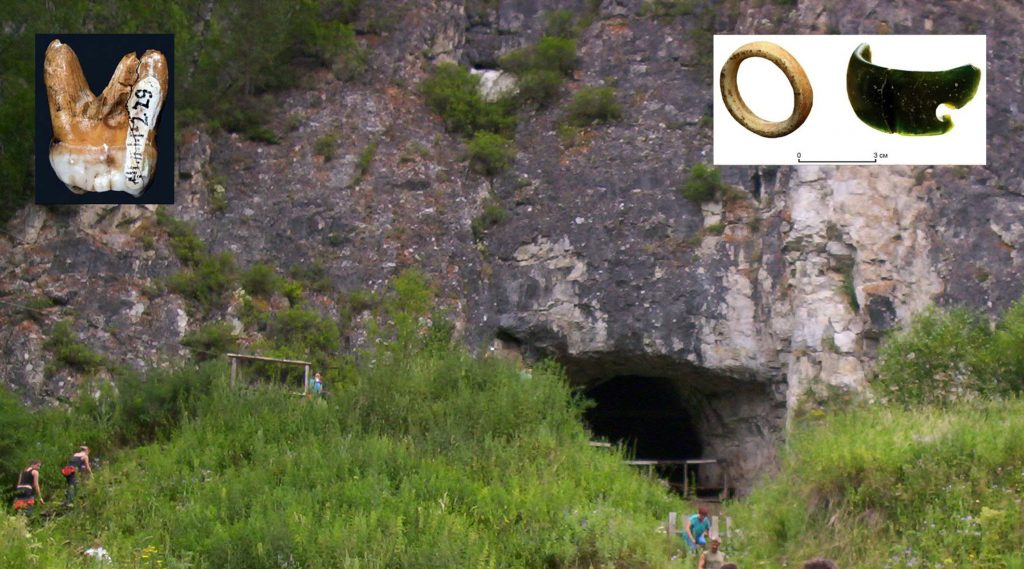
Fig. 2. The Denisova Cave in the Altai Krai region of southern Siberia. Here the Denisovans achieved a remarkable level of technology and knowledge, manufacturing jewellery like the green choritolite bracelet inserted. (Picture courtesy: Wiki Commons Agreement, 2019.)
The importance of these speculations cannot be underestimated. Stone tool specialist Mikkal Sørensen has written that “pressure blade production” emerges for the first time in “the [Central] Mongolian area,” the very area of the Tolbor-16 site, before being carried westward across the Urals into first eastern and then central Europe. Here it was adopted by various cultures of the Upper Paleolithic age, most obviously the highly sophisticated Eastern Gravettians at places like Kostenki and Sungir in western Russia, and afterwards by the Solutreans of southwestern Europe, as well as by the Swiderians, whose original homeland is thought to have been the foothills of the Ural Mountains. Their descendants, as the forerunners of the Uralic or Finno-Ugric-speaking peoples of northern and central Europe, carried these ideas as far north and as far west as Finland and Scandinavia as early as 11,500 years ago.
In Denisovan Origins we argue that the Swiderians were a carrier culture of pre-existing traditions that were responsible for introducing pressure flaking and blade technologies to the pre-pottery Neolithic world of Anatolia and the Near East as early as 9500 BCE. The book also proposes that Swiderian shamans helped catalyse the emergence of cult centres such as Göbekli Tepe, which were at the heart of the great Neolithic revolution in the Near East. From places like this the Neolithic revolution began, spreading out within a few thousand years to every part of Europe, central and southwestern Asia, southwards into the Indian sub-continent, and eastwards into eastern Asia, particularly China.

Fig. 3. General view of the stone enclosures in Göbekli Tepe’s southeast depression with the twin pillars of Enclosure D visible in the foreground. (Picture copyright: Andrew Collins.)
If such speculations prove correct, the Denisovans and Denisovan hybrid groups might well have played an important role in the genesis of modern human civilisation. Understanding the significance of highly specialised types of stone-tool manufacture such as blade tool technologies and pressure flaking thus becomes crucial to our understanding of the emergence of the Upper Paleolithic age. Such ideas, being passed on only through instruction from teacher to pupil, most likely originated in Siberia at sites like Denisova Cave, on the Tibetan Plateau at places like Nwya Devu, and in Mongolia at sites like Tolbor-16.
American Genesis
This is where the peopling of the Americas debate enters the frame. Previously thought to have been first occupied by the enigmatic Clovis culture no earlier than 13,200 years ago, there is now overwhelming evidence both from genetic studies and from archaeology that the earliest habitation of the Americas occurred not just thousands of years earlier, but arguably as early as 20,000 to 30,000 years earlier. What is more, these incursions onto the American continent were not simply a case of mass migrations across the Bering Landbridge. The presence of Australo-Melanesian DNA in certain South American tribes, and also among the Aleuts of the Aleutian Islands, suggests a more complex migrational story–one perhaps involving transpacific journeys that begin in either mainland or island Southeast Asia.
Additionally, a controversial theory backed up both by genetic evidence and stone tool morphology suggests that groups of Solutreans from southwest Europe navigated the Atlantic ice flows stretching between the Bay of Biscay in the east and what is today Chesapeake Bay in the west, and made eventual landfall on the eastern coast of North America. A number of stone leaf points, considered to be pre-Clovis in manufacture, are identified in Denisovan Origins as being very clearly Solutrean in style and in design.

Fig. 4. Map showing the Eurasian and North American landmasses at the time of the Last Glacial Maximum, circa 22,000-18,000 BCE. Note the ice flow that reached the Solutrean territories of southwest Europe and the Chesapeake Bay area of the United States. Here several important pre-Clovis or Paleoamerican bifaces have been found. (Picture copyright: Andrew Collins.)
The Solutrean Hypothesis
Most authors in the Peopling of the Americas field have rejected these findings, because this “Solutrean Hypothesis” has been seized on by white supremacists as evidence that Caucasians reached the Americas before Asians did, via the far east of Russia. However, this rejection is unfounded because the earliest migrations to the Americas not only appear to have come from either eastern or southeast Asia, but also, as you’ll see in Denisovan Origins, there is good reason to suggest that the ancestors of the Solutreans were of North Asian ancestry.

Fig. 5. Two examples of what appear to be Solutrean boats from the caves of Monte Castillo, in Spain’s Cantabria region. The first, top left, is from the Cave of La Pasiega, and dates to circa 16,000 BCE. It appears to show a skiff carrying two individuals. Compare this with the image, bottom left, of a similar abstract impression of a skiff from the Bronze Age rock art site of Bohuslän in Sweden. The second example, seen on the right, is from the El Castillo Cave in Puente Viesgo. Dating to the Late Solutrean period, circa 16,000-15,000 BCE, it could well show a ship with sails on running water. The fact that the caves of Monte Castillo are very close to the Atlantic Ocean should be noted. (Pictures: Public domain/Andrew Collins.)
The reason for highlighting the Solutreans is that they, like the Swiderians, directly descend from the Eastern Gravettians of central and eastern Europe. Their Proto-Solutrean ancestors entered western Europe around 30,000-20,000 years ago, having moved considerably fast across the continent. They brought with them their own unique style of stone tool manufacture that involved pressure flaking as a type of surface reduction, particularly on bifacial leaf points. This was termed “the Solutrean retouch” by prehistorians of the late nineteenth and early twentieth centuries.
As mentioned, there is every reason to conclude that this highly specialised form of stone tool technology originally emerged at sites like Tolbor-16 in central Mongolia. This means it is sensible to surmise that at least some of the stone tool technology used by the Solutreans was developed either by Denisovans or Denisovan-modern human hybrids somewhere in Siberia or Mongolia. If so, then it might well be that along with this very specific form of stone tool manufacture, the Solutreans inherited as least some Denisovan ancestry.
Unfortunately, whether or not the Solutreans had Denisovan ancestry is virtually impossible to prove because so few skeletal remains have been firmly identified as Solutrean. However, Solutrean remains discovered at their type site of Solutré-Pouilly in eastern central France bear striking similarities to the Finno-Ugric peoples of northern Europe, who are themselves most likely of Uralic origin. In other words, Solutrean ancestors had begun their migrational journey beyond the Ural Mountains in western Siberia, and were most likely of North Asian extraction.
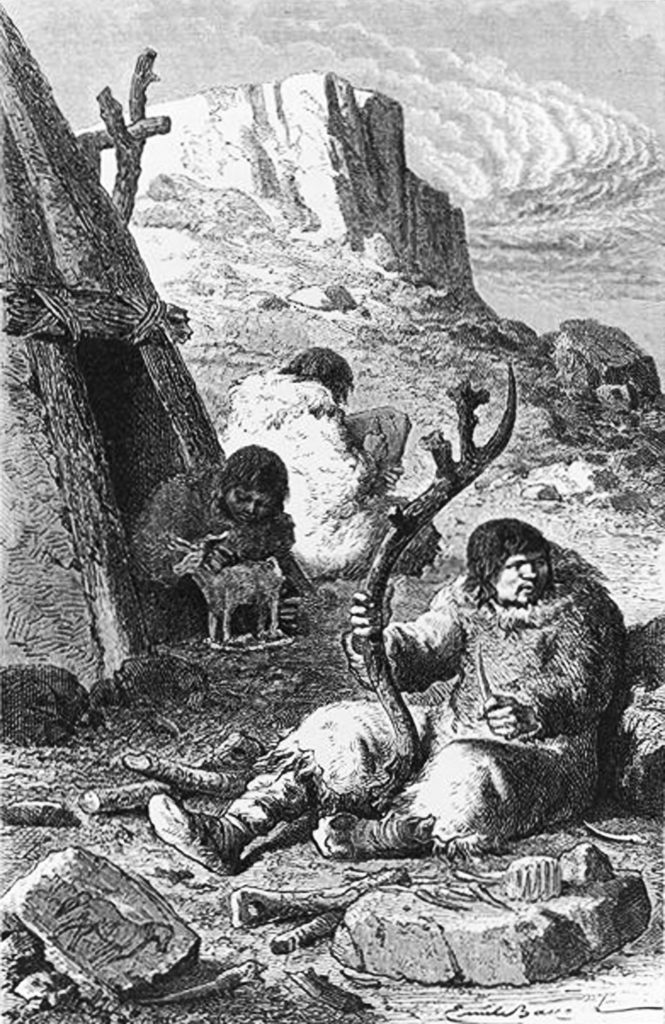
Fig. 6. Gravure print showing the Proto-Solutrean or Solutrean population of southwestern France as clearly Mongolian in origin. Although such views are dismissed by anthropologists today, evidence does suggest that the Proto-Solutreans really were of North Asian origin. (Picture public domain.)
Marauding Hordes
The importance of the Solutreans is that they were more advanced than prehistorians give them credit for. Indeed, they are often seen as a temporary blip in the emerging world of western Europe’s celebrated Upper Palaeolithic age. It is thought that the Solutreans contributed little to the development of this period, a view not helped by the fact that during the late nineteenth and early twentieth centuries their suspected North Asian origins conjured ideas of Mongolian hordes on horses riding through Europe bringing destruction and chaos, like Genghis and Khubla Khan. This is a shame, for there is good evidence that the Solutreans contributed much to Upper Palaeolithic culture in southwest Europe.
The Wind Horse People
The Solutreans’ extraordinary leaf points, some of which are as much as 38 centimetres in length and only a centimetre thick, are of incredible beauty and precision. These long lance points were made not only of flint and obsidian, but also of other, more exotic materials such as amethyst and rock crystal. Indeed, the manner with which they were finished can almost be compared with the Swarovski crystals of our own age, as least visually.

Fig. 7. Exquisite laurel leaf point of Solutrean manufacture found in southern France and today on display in the British Museum. (Picture copyright: Andrew Collins.)
The Solutreans also created the earliest relief art in stone, and erected the earliest known menhirs or standing stones. They may well have ridden horses, something that led to their epoch being coined “the Wind Horse period”. They are also known to have buried their dead on fire hearths marked by an oval area of closely fitting stone blocks with standing stones each side of the head. They also created some of the most enigmatic cave art of the Upper Paleolithic age, including that seen in Lascaux’s Shaft of the Dead Man and also that at Pech Merle. Yet strangely, the Solutreans’ contribution to Ice Age cave art, whether it be stone carved relief art or painted art, is largely ignored by academia–arguably a leftover of the distaste for Solutreans created by prehistorians of the late nineteenth and early twentieth centuries.
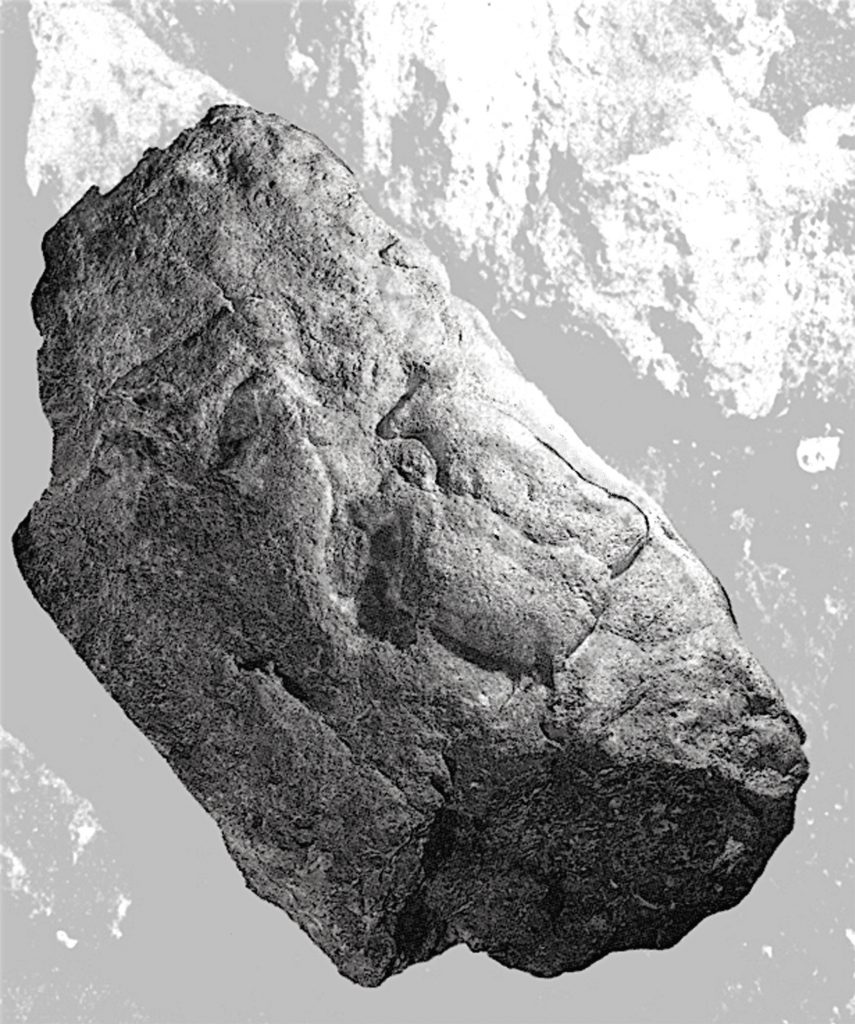
Fig. 8. Large block found standing at the entrance to the Fourneau-du-Diable rock shelter in France’s Dordogne region. The stone’s exact angle of leaning is reproduced on an original picture of the boulder taken shortly after its discovery in 1924. (Picture copyright: Andrew Collins.)

Fig. 9. Rare illustration of one of the Solutrean hearth graves found at Solutré-Pouilly in eastern-central France, showing the immense sophistication of its construction. (Picture public domain)
The fact that the Solutreans might have continued their westward migration onto the Atlantic ice and found their way to the Americas should therefore not come as a shock, for there is every reason to suggest that they were an immensely sophisticated culture with North Asian ancestry that dated back to the age of the Denisovans.
The First Americans
The Americans who possess the greatest potential levels of Denisovan ancestry are the Ojibwa, one of the largest tribes in North America. Although their homeland was originally far to the east in the St Laurence River basin, their current day territories extend from Ontario in Canada down to the Great Lakes region into Minnesota and Wisconsin. The Cree (or Oji-Cree) also possess Denisovan DNA, although at a lower level than the Ojibwa. Their ancestral home was immediately north and west of the Ojibwa in Ontario, Manitoba, Saskatchewan, Alberta, and the Northwest Territories. They have around 200,000 members today, who live almost exclusively in Canada.
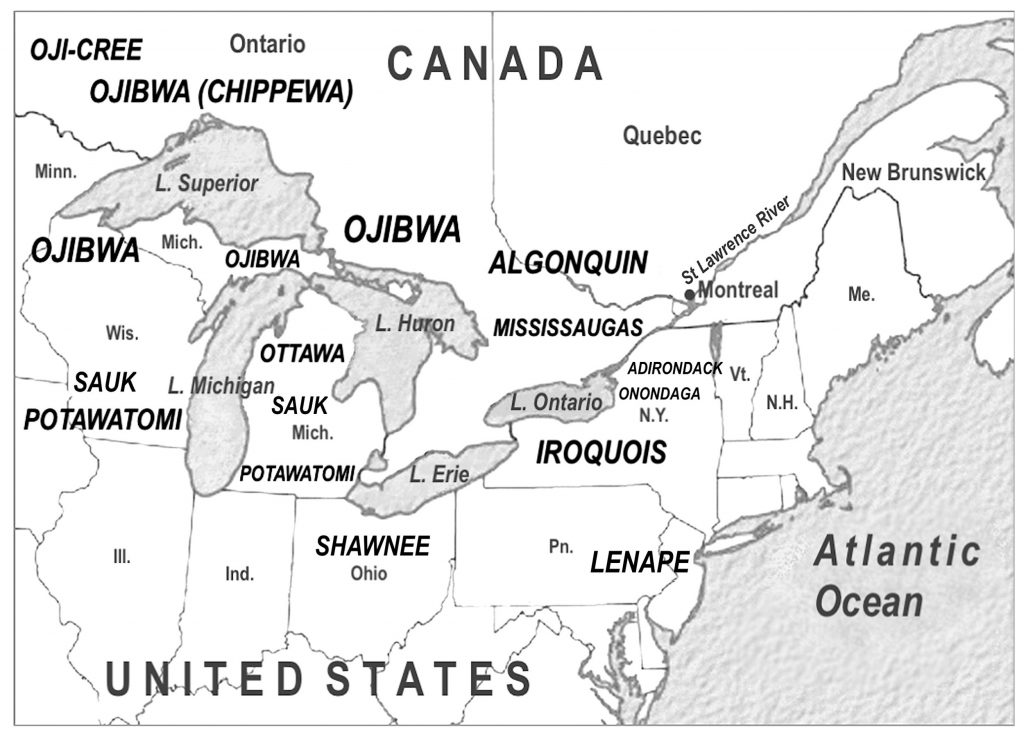
Fig. 10. Map showing the territories of First Peoples of the Great Lakes and St Lawrence River region of the United States and Canada mentioned in the book. (Picture copyright: Andrew Collins.)
These facts, although interesting, tell us very little about the possible origins of Denisovan ancestry in the Americas. Nor do they tell us if Denisiovan ancestry arrived with Solutreans with roots in North Asia coming from the east, or with groups of eastern, southeastern and northern Asian peoples inbound from the eastern part of the Eurasian continent.
The mystery deepens in that the highest frequency of an enigmatic mystery strain of mitochondrial DNA (mtDNA) called haplogroup X that is found almost exclusively among modern populations in southwest Europe, the homeland of the Solutreans, as well as the eastern Mediterranean, Orkney Isles of Scotland, and the Altai region of southern Siberia, is also found among some Native American groups.
The tribe possessing the highest level of haplogroup X is the Ojibwa. Up to 26 percent of its population’s mtDNA is haplogroup X, while the Cree possess haplogroup X, but at a slightly lower level than the Ojibwa.
Both the Ojibwa and Cree form part of what is known as the Algonquian language-speaking group. This collective of First Nations often refer to themselves as the Anishinaabe (plural Anishinaabeg), a word meaning, simply, “original people.” Those belonging to this interlinked network of tribes, all of which are located in the northern and northeastern parts of the North American continent, include the Potawatomi, Mississaugas, Cree, Chippewa (a form of Ojibwa), Ottawa, Ojibwa, and, of course, the Algonquin themselves.
Despite the ethnic and cultural unity of the Anishinaabeg, it is only the Ojibwa and Cree that possess significant levels of Denisovan ancestry (others tribes that have it to a lesser degree include the eastern Algonquin, whose surviving territories are beyond the northeastern limits of the Great Lakes region, and the Tlingit of the Pacific Northwest).
The fact that the Ojibwa possess the highest percentage both of Denisovan DNA and of haplogroup X in North America cannot be ignored. How can this be so? What is the relationship between Denisovan ancestry and haplogroup X? Do they derive from the same genetic background? Did both come from Europe with the Solutreans, or did they somehow reach the Americas through some other means? Such is the mystery tackled by Greg and I in Denisovan Origins.
Path of Souls
Both the Ojibwa and Cree possess strong beliefs in the cosmic death journey known as the Path of Souls, which was common among at least thirty to forty tribes in the Americas at the time of first contact. This involved a leap of faith to a star or constellation close to where the ecliptic, that is, the sun’s path through the sky each year, crossed the Milky Way in only one of two places along its course. According to Ojibwa tradition, this point of access to the Milky Way was achieved via the Pleiades/M45 star cluster, located in the constellation of Taurus, the bull.
Other tribes accessed the Milky Way via the M42 nebula in the Orion constellation. Once on the starry path, the soul encountered various celestial obstacles, the last being “a man,” occasionally a woman, who would cleave open the skull and remove the brain, an act that convinced the individual’s shadow self to return to the grave. Other tribes also spoke of this brain removal process, explaining that it took place where the Milky Way forks in two to create two separate log bridges, only one of which led to the afterlife. This important celestial location has confidently been identified as the northern opening to the Milky Way’s Dark Rift, marked by the stars of the Cygnus constellation. This fork in space then acts as the final portal into the sky world proper.
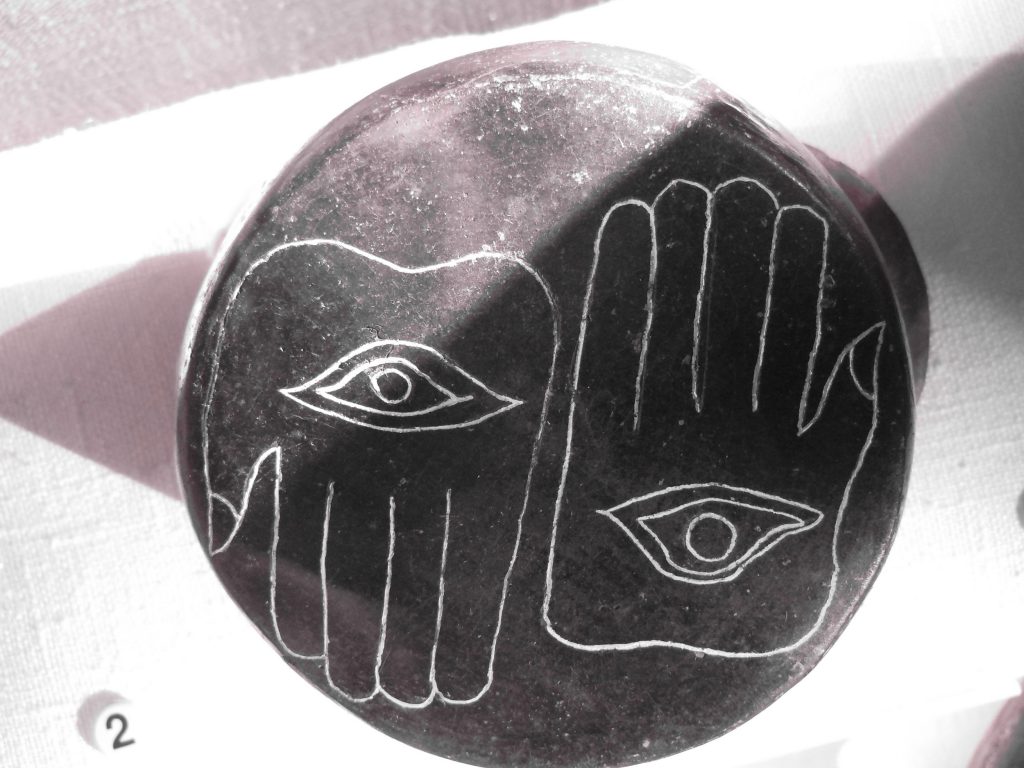
Fig. 11. Orion as a double hand symbol as seen on a ceramic platter in the museum at Moundville, Alabama. The “eye” in the centre of the hand is almost certainly the M42 nebula in the sword of Orion. This was seen as an “ogee” or portal on to the Milky Way. (Picture copyright: Andrew Collins)
The sky creature responsible for the brain-removal process was Brain Smasher. He (or she on occasions) usually took the form of a raptor, most obviously an eagle or hawk, or a human figure with hooked beak and avian wings. More significantly, this supernatural creature has been identified with either the star Deneb or the Cygnus constellation as a whole.
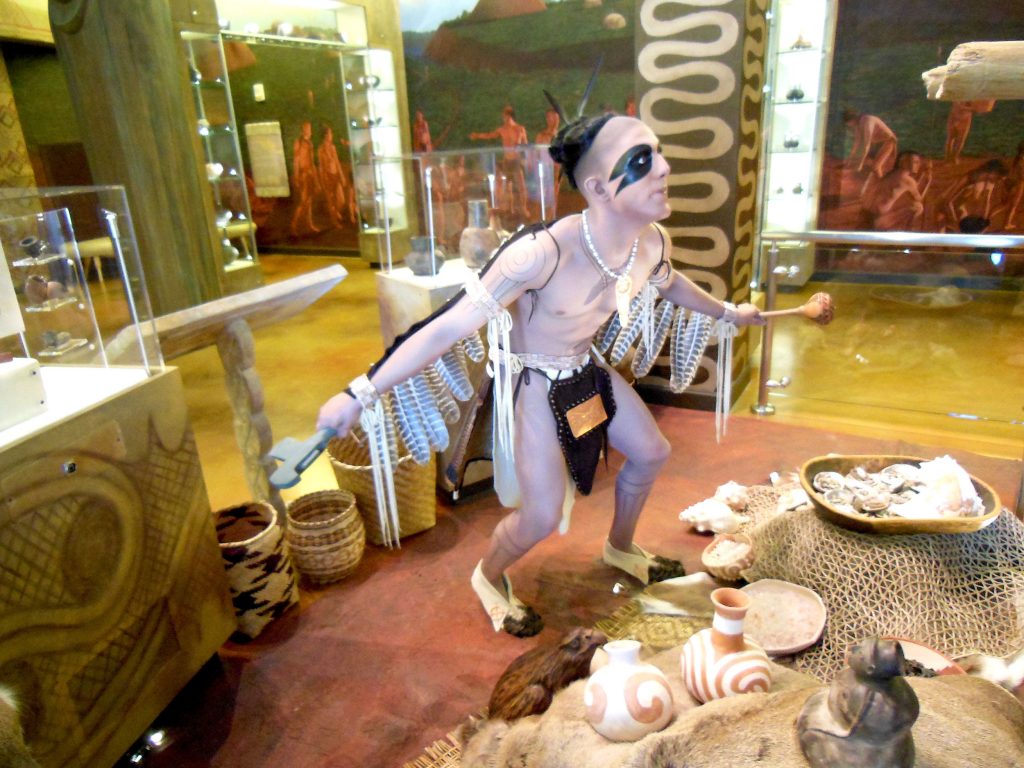
Fig. 12. Mississippian era shaman dressed as a bird man representing the character Brain Smasher encountered on the Path of Souls cosmic death journey. In the sky Brain Smasher is identified with the constellation of Cygnus, the celestial bird. It acts as the final portal allowing the soul access to the afterlife. (Picture copyright: Andrew Collins.)
These ideas are also expressed in the layout and placement of individual components of mound complexes across the United States. These sites, which date to the Adena, Hopewell and Mississippian periods, show a consistency of interest in very specific astronomical targets, most commonly the bright star Deneb and the stars of Orion, spanning a period of at least 2000 years. As Graham Hancock explains in America Before, this belief in a universal death journey involving Orion, Cygnus and the Milky Way, must predate the isolation of the American continents and be at least 12,000 years old.
If this is correct then the chances are it is infinitely older still, and had its inception on the Eurasian continent where these ideas are found–for instance in ancient Egypt, at Göbekli Tepe and among every ancient culture that orientated its monuments towards Cygnus, Orion or the Pleiades. Very clearly these ideas are extremely old, and may well date back to the age of the Denisovans whose descendants appear to have been the first to display a more or less obsessive interest in cyclic time associated with the sun, moon and stars.
As Greg and I explain, there is every reason to propose that the Denisovans had a completely different mindset to that of modern humans–one who acted like that of a person who would today be on the autistic spectrum. If correct, then there is every reason to suppose that they might have had savant-like qualities, enabling them to advance faster than their western counterparts, the Neanderthals. This is suggested by the fact that the Denisovans are known to have possessed two genes–ADSL and CNTNAP2–that when mutated can cause autism in modern human populations.
Is it possible that autism, and the savant-like qualities that accompany autism, were responsible for the rise of the shamanic civilisation at the start of the Upper Paleolithic age? This is the theory proposed and outlined in Denisovan Origins, a vision that is admittedly far from being proven, but thought provoking nevertheless.
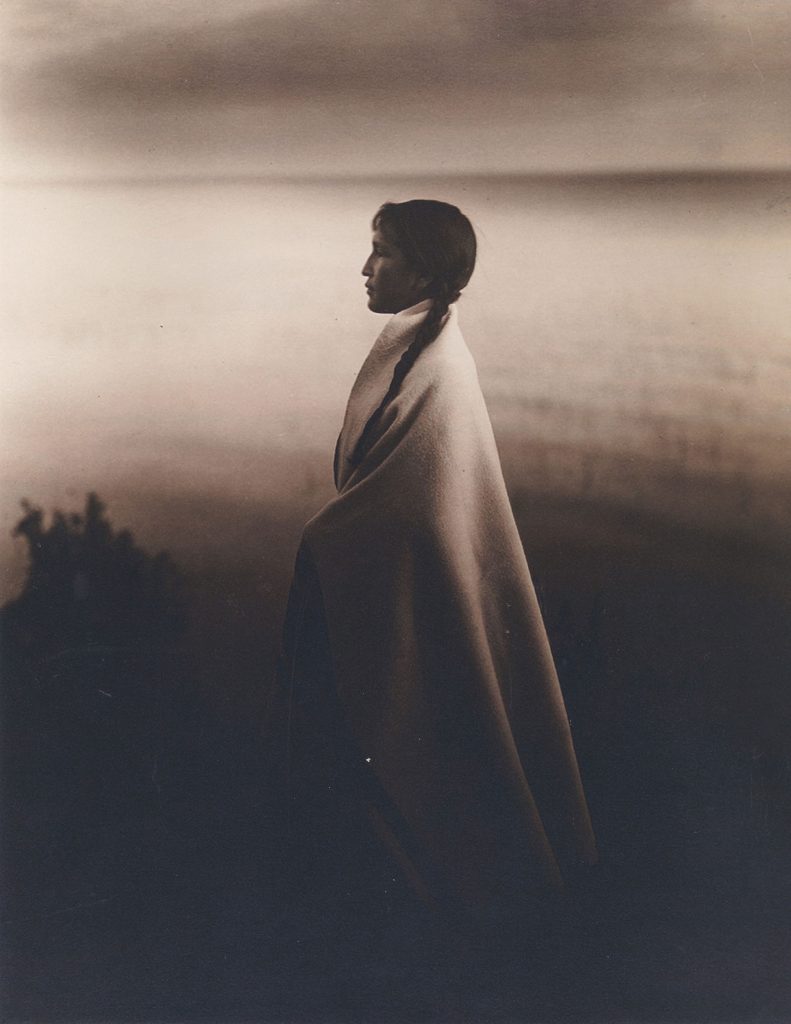
Fig. 13. Ojibwa woman on the shores of one of the Great Lakes. The Ojibwa possess more Denisovan ancestry than any other First Peoples in North America, as well as the highest incidence of haplogroup X—the mystery strain of mitochondrial DNA, or mtDNA. (Picture public domain.)
Bibliography
Browning, Sharon R., Brian L. Browning, Ying Zhou, Serena Tucci, and Joshua M. Akey. 2018. “Analysis of Human Sequence Data Reveals Two Pulses of Archaic Denisovan Admixture.” Cell 173, 1–9.
Chen, Fahu, et. al. 2019. “A late Middle Pleistocene Denisovan mandible from
the Tibetan Plateau.” Nature Research Letter 569 (May 16): 410-412.
Childe, V. Gordon. 1956. “Kostienki ‘East Gravettian’ or ‘Solutrean’”? University of London Institute of Archaeology, Twelfth Annual Report, 8–19.
Clottes, J. (dir.). 2012. L’art pléistocène dans le monde / Pleistocene art of the world / Arte pleistoceno en el mundo Actes du Congrès IFRAO, Tarascon-sur-Ariège, septembre 2010 – Symposium « Datation et taphonomie de l’art pléistocène, LXV-LXVI, 2010–2011, CD and book. Tarascon-sur-Ariège, France: Société Préhistorique Ariège-Pyrénées.
Collins, Andrew. 2018. The Cygnus Key: The Denisovan Legacy, Göbekli Tepe, and the Birth of Egypt. Rochester, Vt.: Bear and Co.
Derev’anko, Anatoliy, 1998. The Paleolithic of Siberia: New Discoveries and Interpretations. Translated by Inna P. Laricheva. Urbana and Chicago: University of Illinois Press.
Derevianko, Anatoliy, and S. Markin. 1998. “The Paleolithic of the Altai.” In Derev’anko, 84–106.
Derevianko, Anatoliy, M. V. Shunkov, and P. V. Volkov. 2008. “A Paleolithic Bracelet from Denisova Cave.” Archaeology Ethnology & Anthropology of Eurasia 34, no. 2: 13–25.
Desrosiers, Pierre M. 2012. The Emergence of Pressure Blade Making: From Origin to Modern Experimentation. New York: Springer.
Hancock, Graham. 2019. America Before: The Key to Earth’s Lost Civilization. New York, NY.: Coronet.
Huerta-Sánchez, Emilia, et al. 2014. “Altitude Adaptation in Tibetans Caused by Introgression of Denisovan-Like DNA,” Nature 512, no. 7513 (August 14): 194–97.
Lankford, George E. 2004. “The ‘Path of Souls’: Some Death Imagery in the Southeastern Ceremonial Complex.” In Reilly III and Garber, 174–212.
Lbova, Liudmila, Darya Kozhevnikov, and Pavel Volkov. 2012. “Musical Instruments in Siberia (Early Stage of the Upper Paleolithic).” In Clottes, CD-1900 to CD-1904.
Le Maire, J. 1619. Relación diaria del viage de Iacobo Demayre y Guillermo Cornelio Schouten. Madrid: Guzman.
Little, Gregory L. (2014) 2016. The Illustrated Encyclopedia of Native American Indian Mounds and Earthworks. Memphis, Tenn.: Eagle Wing Books, Inc.
———. 2015. Path of Souls. Video documentary. Memphis, Tenn.: ATA Memphis Productions.
———. 2016. “America’s Ancient Indian Mounds Yield Secrets.” Newswire.com, March 7.
———. 2016. “America’s Ancient Mound Alignments to Stars Reveal Widely-Shared Rituals and Beliefs.” AP Magazine, June.
Miller, Dorcas S. 1997. Stars of the First People: Native American Star Myths and Constellations. Boulder: Pruett Publishing Company.
Oppenheimer, Stephen, Bruce Bradley and Dennis Stanford. 2014. “Solutrean Hypothesis: Genetics, the Mammoth in the Room.” Journal of World Archaeology 46, no. 5: 752–74.
Qin, Pengfei, and Mark Stoneking. 2015. “Denisovan Ancestry in East Eurasian and Native American Populations.” Molecular Biology and Evolution 32, no. 10: 2665–74.
Racimo, F., D. Gokhman, M. Fumagalli, A. Ko, T. Hansen, I. Moltke, A. Albrechtsen, L. Carmel, E. Huerta-Sánchez, and R. Nielsen. 2017. “Archaic Adaptive Introgression in TBX15/WARS2.” Molecular Biology and Evolution 34, no. 3 (March 1): 509–24.
Reich, David. 2018. Who We Are and How We Got Here. New York: Pantheon.
———. 2010b. “Supplementary Information: Genetic History of an Archaic Hominin Group from Denisova Cave in Siberia.” Nature 368, no. 7327 (December 22).
Reidla, Maere, et al. 2003. “Origin and Diffusion of mtDNA Haplogroup X.” American Journal of Human Genetics 73, no. 5: 1178–90.
Reilly, F. Kent, and James F. Garber, eds. 2007. Ancient Objects and Sacred Realms: Interpretations of Mississippian Iconography. Austin: University of Texas Press.
Sankararaman, Sriram, Swapan Mallick, Nick Patterson, and David Reich. 2016. “The Combined Landscape of Denisovan and Neanderthal Ancestry in Present-Day Humans.” Current Biology 26, no. 9 (May 9): 1241–47.
Sawyer, Susanna, Gabriel Renaud, Bence Viola, Jean-Jacques Hublin, Marie-Theres Gansauge, Michael V. Shunkov, Anatoly R. Derevianko, Kay Prüfer, Janet Kelso, and Svante Pääbo. 2015. “Nuclear and Mitochondrial DNA Sequences from Two Denisovan Individuals.” Proceedings of the National Academy of Sciences of the United States of America 112, no. 51 (December 22): 15696–700.
Schraiber, F. Jay, K. Prüfer, C. de Filippo, et al. 2012. “A High-Coverage Genome Sequence from an Archaic Denisovan Individual.” Science 338, no. 6104 (October 12): 222–26.
Skoglund, Pontus, et al. 2015. “Genetic Evidence for Two Founding Populations of the Americas.” Nature 525 (September 3): 104–8.
Sørensen, Mikkel. 2012. “The Arrival and Development of Pressure Blade Technology in Southern Scandinavia.” In Desrosiers, 237–59.
Stanford, Dennis J., and Bruce A. Bradley. 2012. Across Atlantic Ice: The Origins of America’s Clovis Culture. Berkeley: University of California Press.
Viola, Bence T., et al. 2019. “A parietal fragment from Denisova cave.” The 88th Annual Meeting of the American Association of Physical Anthropologists, Cleveland, March 28, 2019.
Warren, William Whipple. (1885) 2009. History of the Ojibway People. St. Paul: Minnesota Historical Society.
Zhang, X.L., et al. 2018. “The earliest human occupation of the high-altitude Tibetan Plateau 40 thousand to 30 thousand years ago.” Science 362: 6418 (Nov 30): 1049-1051.
Zwyns, Nicolas, et al. 2014. “The Open-Air Site of Tolbor 16 (Northern Mongolia): Preliminary Results and Perspectives.” Quaternary International 347 (June): 53–65.
Zwyns, Nicolas, et al. 2019. “The northern Route for Human dispersal in central and northeast Asia: new evidence from the site of Tolbor-16, Mongolia.” Nature Research Scientific Reports 9:11759. https://www.nature.com/articles/s41598-019-47972-1.






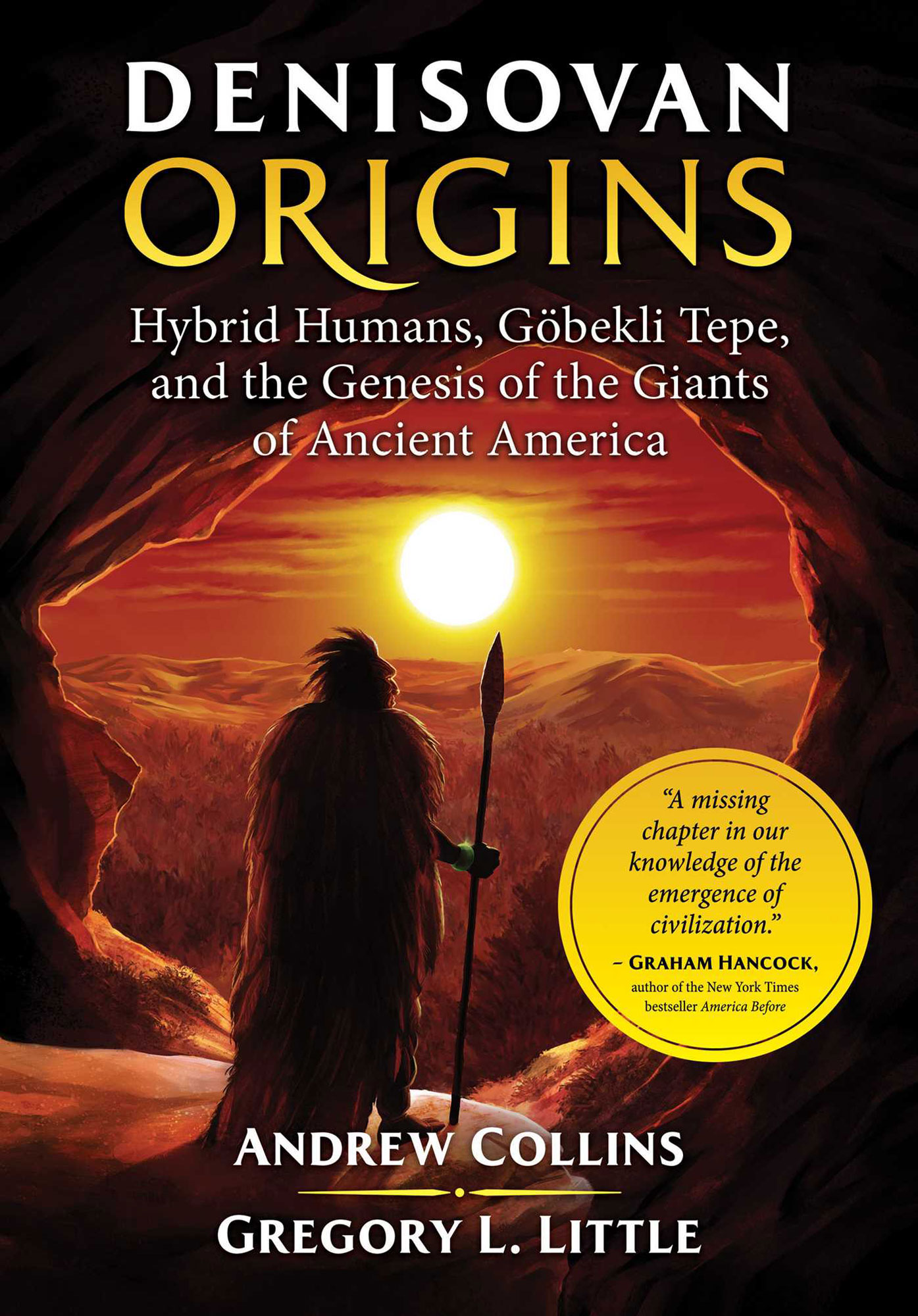


Path of Souls….If you look on page 192 of Native American Architecture (Oxford Press), you will find a drawing of an Eskimo house in the shape of a swan. Thanks
Fascinating article. The book, which I have already read, represents an enormous amount of research of very high quality by two serious researchers. Well…..I am surprised by the lack of comments, especially on a site like this one. There is much food for thought…
Spot on with this write-up, I honestly think this web site
needs a lot more attention. I’ll probably be back again to read through more, thanks for the info!